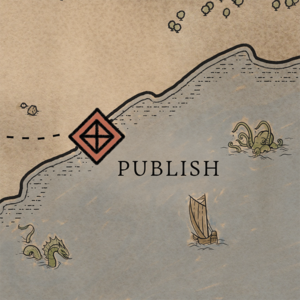 You’ve trained, toiled, and triple-checked all your gear. It’s time to launch your book into Publish Bay to explore the expansive waters of a broad audience here at the end—or an end—of your book journey.
You’ve trained, toiled, and triple-checked all your gear. It’s time to launch your book into Publish Bay to explore the expansive waters of a broad audience here at the end—or an end—of your book journey.
Check Your Rigging
I’d love to tell you that after the long journey thus far, publishing is a simple as shouting, “I declare this book published!” and setting sail. But that would make me a liar.
Before you start selling your book, you usually need to get a printed copy or two so you can check for any printing problems and correct them before launch. You should also pull the trigger on any final pre-publishing marketing efforts. (These shouldn’t be your first marketing efforts, though. Marketing should be an ongoing, ever-growing strategy. Even if you do nothing else, you can share your cover design as soon as it’s done!)
Depending on your distribution plan, you may need to upload your print and ebooks to multiple sales platforms (like Amazon, Kobo, Apple Books, and more). You need to pick out metadata and keywords and select your pricing. Even when the sea looks calm, here be monsters.
Help Along the Way
The good news is that most distribution services for self-publishers have had a while to sort out the tricky bits, and they have help menus and chat lines and message boards to navigate you through the bay and out into open waters.
Distribution Avenues
Distribution for your books can take many different forms, but for today I’ll focus on ebook distribution and print-on-demand (POD) providers for self-publishers. (For some print books, POD is a poor fit, but most self-published pieces do fine with it.)
- Amazon: To print and distribute ebooks through Amazon, you’ll use their KDP system. For print, you’ll need a PDF of your book’s interior and a PDF of the full wraparound cover—with the bleed. (Your guide from the Design Pines should know how to calculate the bleed, etc.) For the ebook, you need a file ready for Amazon to convert to their proprietary format (if you had a designer create your EPUB, it should convert smoothly). Once you’re logged into KDP, the Help menu provides specific assistance. KDP also has an option for you to enroll in Kindle Unlimited, a method to earn money for the amount of your book a reader reads rather than on a full book sale. (But careful about signing up—if you’re enrolled in KU, your ebook should only be available for sale on Amazon until your 90-day enrollment expires.) KDP is free to use.
- Ingram Spark: Ingram Spark has a $25–$50 setup fee for each title, but it does provide a few advantages on the KDP system for different books. For starters, brick-and-mortar bookstores have an easier time ordering copies from Ingram Spark than from KDP. This isn’t necessary for every book, but if your book’s success requires easier access to physical outlets, it’s essential. Ingram Spark also offers more print formats—a wider variety of trim sizes, access to various hardcover print options—than KDP.
- Kobo: I’m writing from the United States, where Kobo is not as popular as other outlets. But internationally, Kobo is more significant than it is here, and it has a fairly user-friendly interface.
- Apple Books: Apple is another strong outlet for ebooks that’s especially tailored for folks using iOS devices. I find it particularly well suited to enhanced and fixed-layout ebooks.
- Barnes & Noble: B&N also had a dedicated platform for self-publishers to upload their books.
- Multiplatform Distributors: If uploading your book to all these platforms is intimidating, you can use a multiplatform distributor like Draft2Digital or Smashwords to get your book available on various ebook platforms. They can also make it easier to be on OverDrive and other library systems.
Printers & Binders
If you have a higher-cost print project—a comic book, full-color picture book, or a luxuriously bound book—you’re probably better off avoiding the POD systems and getting a small print run directly from a print-and-bindery company. This means you’ll order a bunch of printed books up-front. So the printing cost for an individual book is significantly lower than it is through POD systems. But you’ll need to store those books somewhere and handle shipping and distribution on your own. I’ve seen this system work particularly well for books that are crowdfunded through Kickstarter and similar platforms.
Project Managers
Sometimes you can hire someone to act as a project manager to take care of file uploads, updates, and platform compliance for your book, or you can hire someone to walk you through the process. But if you feel up to tackling something new, there are plenty of resources to help guide you through the process!
Celebrate the Journey!
Even though I can’t say publishing is simple, I can tell you that you have come an enormously long way and should be proud of yourself. Take a while to appreciate your efforts. You wrote, revised, and edited a book, and you guided it through copyediting and design processes. Any leg of the book-making journey is a quest unto itself, and you’ve made it through a whole string of them.
This book’s journey is just beginning. It’s on its way to readers who will encounter it and interpret it in new and interesting ways. You’ll continue to share it, market it, and adjust your publishing strategies as times change. Along the way, be sure to take care of yourself and to love your audience, whether it’s big or small.
And when you’re ready for a new journey, head back to the Draft Marshes and start another book!
Have questions about the nitty-gritty of navigating Publish Bay? Ask them in the comments!




Leave a Reply